Chess Notes
Edward Winter
When contacting us by e-mail, correspondents are asked to include their name and full postal address and, when providing information, to quote exact book and magazine sources. The word ‘chess’ needs to appear in the subject-line or in the message itself.
| First column | << previous | Archives [103] | next >> | Current column |
7956. Chapman v Coates
A game which will be added to Royal Walkabouts:
C. Chapman (Kent) – C. Coates (Cheshire)
Correspondence
Petroff Defence
1 e4 e5 2 Nf3 Nf6 3 d4 exd4 4 e5 Ne4 5 Qe2 Bb4+ 6 Kd1 d5 7 exd6 f5 8 dxc7 Qxc7 9 Nxd4 O-O 10 Qc4+ Qxc4 11 Bxc4+ Kh8 12 Ke2 Re8 13 Bb5 Bd7 14 Kf3 Nc6 15 Nxc6 bxc6 16 Rd1 Nf6 17 Ba4 f4 18 h3 g5 19 a3 g4+ 20 hxg4 Bxg4+ 21 Kxf4 Ba5 22 Kg5
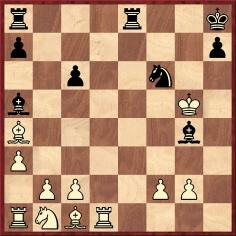
22...h6+ 23 Kxf6 Bd8+ 24 Rxd8 Raxd8 25 Bxh6 Rd5 26 Kf7 Re6 27 Bg7+ Kh7 28 Bb3 Rd7+ 29 Kf8
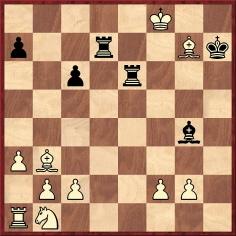
29...Re2 30 f4 Rxg7 31 Nc3 Rd2 32 Rh1+ Kg6 33 f5+ Bxf5 34 Rd1 Rf2 35 Ke8 Rb7 36 White resigns.
Sources: BCM, May 1915, page 173; Chess Amateur, August 1915, page 327; The “British Chess Magazine” Chess Annual 1915 by I.M. Brown (Leeds, 1916), page 171.
7957. Misidentification
Together with a version of even better quality, C.N. 7602
reproduced this photograph (New York, 1927) from page 60
of the March 1927 American Chess Bulletin:
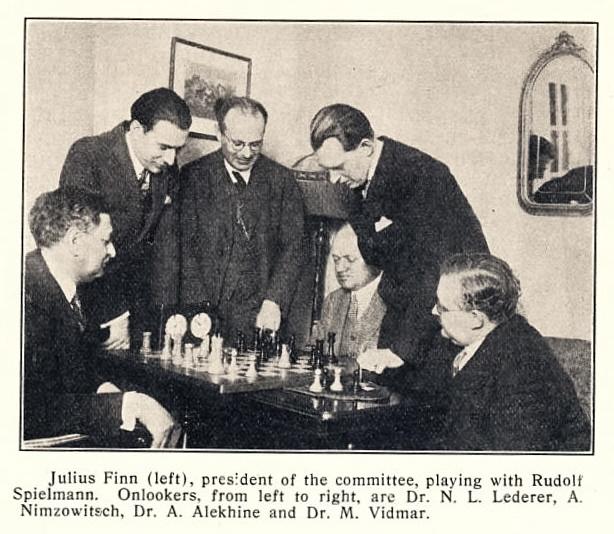
A much poorer version, with an even poorer caption, has appeared on page 45 of Alexander Aljechin Biografie des 4. Schachweltmeisters by W. Daniel (Eltmann, 2012):
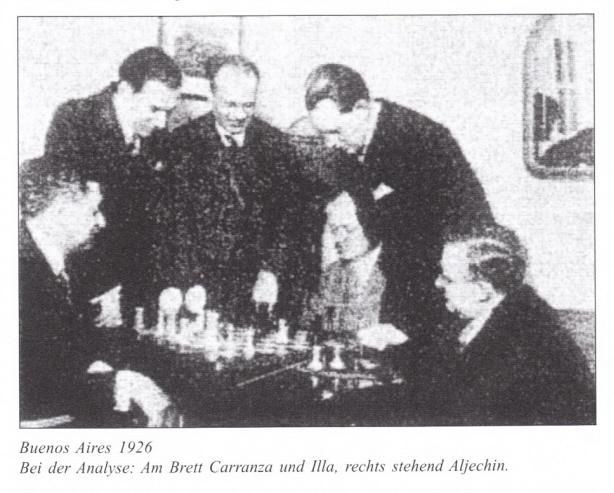
7958. Chess as a detective
John Blackstone (Las Vegas, NV, USA) sends this item from page 3 of The Sun (New York), 12 March 1895:


We read the appeal as coming from Daniel R. Brooks, 4
Barker Street, Harpurhey, Manchester, England. A news
report about the Manchester Chess Club on page 288 of the
October 1897 American Chess Magazine mentioned a
player named D.R. Brooks.
7959. Found
Further to C.N. 7958, John Blackstone has now found a follow-up news item which was published on page 6 of The Sun, 5 April 1895:
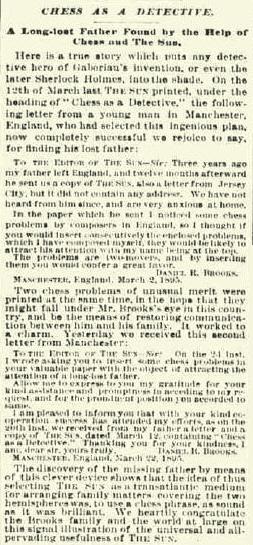
7960. Reinfeld on chess myths
Some observations by Fred Reinfeld on pages 1-2 of The Secret of Tactical Chess (New York, 1958):
‘Chess has been subjected to several myths which need puncturing. One of the most prevalent is that some people become chess addicts, neglecting wife, children, job. I have played chess and known chessplayers for 35 years, and have not yet come across an instance of this kind. I have known people who passionately loved chess who were famous authors, eminent scientists, distinguished professionals in many fields, and the like. So I would say that the myth of the chess addict belongs to the same category of American folklore as does the myth of the absent-minded professor.’
7961. Rubinstein trap
Eduardo Bauzá Mercére (New York, NY, USA) draws attention to this example of the ‘Rubinstein Trap’ in a game published on page 14 of the Brooklyn Daily Eagle, 15 April 1915:
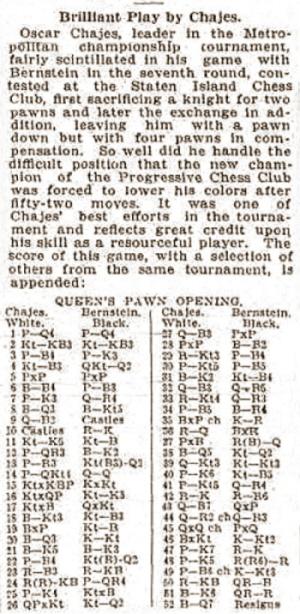
Oscar Chajes – Jacob Bernstein
Metropolitan Chess League individual championship,
New York, 10 April 1915
Queen’s Gambit Declined
1 d4 d5 2 Nf3 Nf6 3 c4 e6 4 Nc3 Nbd7 5 cxd5 exd5 6 Bf4 c6 7 e3 Qa5 8 Bd3 Bb4 9 Qc2 O-O 10 O-O Re8 11 Ne5 Nf8 12 a3 Be7 13 h3 N6d7 14 b4 Qd8

15 Nxf7 Kxf7 16 Nxd5 Ne6 17 Nxe7 Qxe7 18 Bg3 Nf6 19 Bxh7 Nf8 20 Bd3 Kg8 21 Be5 Be6 22 f4 N8d7 23 Rf3 Rf8 24 Raf1 a5 25 e4 Nxe5 26 dxe5 Nd7 27 Qc3 axb4 28 axb4 Bf7 29 Rg3 c5 30 b5 c4 31 Be2 Nc5 32 Qf3 Qh4 33 Rg4 Qh6 34 f5 Bh5 35 Bxc4+ Kh8
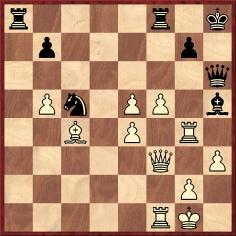
36 Rd1 Bxg4 37 hxg4 Rfd8 38 Bd5 Nd7 39 Qg3 Nb6 40 e6 Nc4 41 g5 Qh5 42 Re1 Ra3 43 Qc7 Qxg5 44 Qh2+ Qh6 45 Qxh6+ gxh6 46 Bxc4 Kg7 47 e7 Re8 48 e5 Raa8 49 f6+ Kg6 50 Rf1 Rac8 51 Be6 Ra8 52 Bd7 Resigns.
7962. Henrique Mecking (C.N. 4851)
In an interview on page 42 of the January 2013 BCM Mecking states categorically that he was born on 23 January 1952.
7963. F.M. Edge
From John Townsend (Wokingham, England):
‘There is an entry in the International Genealogical Index which suggests that F.M. Edge’s parents, Thomas Edge and Eleanor Milnes, married at Manchester Cathedral on 29 April 1829, and I have checked the full entry in the Cathedral’s register.
Regarding the uncertainty over the middle name of F.M. Edge (i.e. whether it was Milne, Milns or Milnes) it may be noted that Thomas Edge is described as “Widower, of the Parish of Saint John the Evangelist Westminster, Brass founder” and that the bride is listed as “Eleanor Milnes of this Parish, Spinster”. Both parties signed the register, the bride as “Eleanor Milnes”. One of the three witnesses was Elizabeth Edge.’
7964. Sozin and the Meran Defence (C.N.s 7813, 7843 & 7848)
Luca D’Ambrosio (Bolzano, Italy) notes that in the position after 1 d4 Nf6 2 c4 e6 3 Nf3 d5 4 Nc3 c6 5 e3 Nbd7 6 Bd3 dxc4 7 Bxc4 b5 8 Bd3 a6 9 e4 c5 10 e5 cxd4 11 Nxb5 the move 11...Nxe5 is ascribed to Georges Renaud on page 143 of the May 1925 Deutsche Schachzeitung (see the illustration below), on page 352 of the July-September 1927 Kagans Neueste Schachnachrichten and on page 405 of André Chéron’s Traité complet d’échecs (Brussels, 1927).
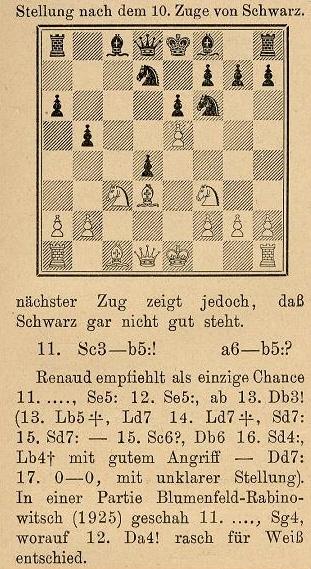
Our correspondent asks when Renaud recommended or played 11...Nxe5.
7965. Colourful descriptions
Wanted: players’ colourful descriptions of their playing style. From page 77 of the March 1916 BCM, in a feature on R.F. Fenton:
‘To his friends it is always a pleasure to watch the way in which he demolishes the positions of his casual opponents by the process which he himself describes as “sapping and mining” ...’
7966. Brilliant terminations
An observation about J.H. Blackburne on page 54 of The “British Chess Magazine” Chess Annual 1915 by I.M. Brown (Leeds, 1916):
‘Has probably brought off more brilliant terminations than any player who ever lived.’
7967. Double sacrifice
A combinative finish published on page 68 of Schachjahrbuch für 1914 II. Teil by L. Bachmann (Ansbach, 1914):
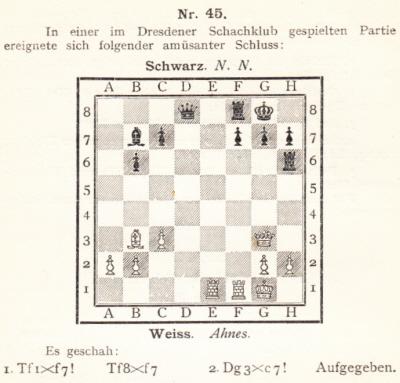
In some other sources, such as pages 56 and 108 of Your Move! by Y. Neishtadt (London, 1990), it is stated that the position occurred in Ahues v Leopold, Dresden, 1903.
7968. Two Knights’ Defence
From Eduardo Bauzá Mercére (New York, NY, USA) comes this cutting from page 3 of the Brooklyn Daily Eagle, 20 November 1919:

The first game is indeed extraordinary, and we seek further details. 1 e4 e5 2 Nf3 Nc6 3 Bc4 Nf6 4 Ng5 Bc5 5 Nxf7 Bxf2+ 6 Ke2
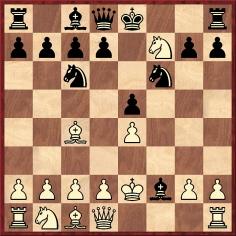
6...Nxe4 7 Nxd8 Nd4+ 8 Kd3 b5 9 Bb3 Nc5+ 10 Kc3
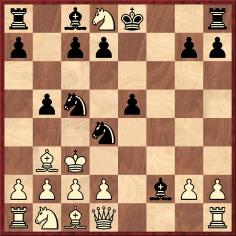
10...Ne2+ 11 Qxe2 Bd4+ 12 Kb4 a5+ 13 Kxb5 Ba6+ 14 Kxa5

14...Bd3+ 15 Kb4 Na6+ 16 Ka5
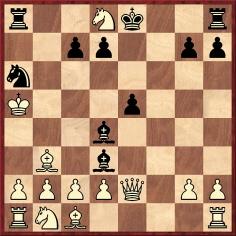
16...Nb4+ 17 Kxb4 c5 mate.
Addendum: Olimpiu G. Urcan (Singapore) notes the following on page 3 of the Brooklyn Daily Eagle, 26 November 1919:
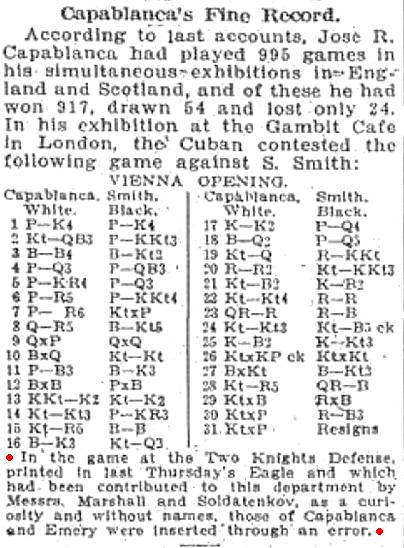
7969. Steinitz and anti-Semitism (C.N. 7952)
David Nudelman (Hamden, CT, USA) submits this title page:
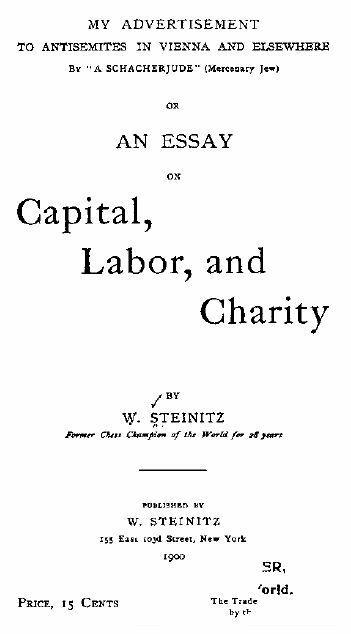
See too pages 382-386 of William Steinitz, Chess Champion by Kurt Landsberger (Jefferson, 1993).
7970. For solving (C.N. 7955)
The two compositions in C.N. 7955 were by George E. Carpenter, taken from page 209 of Checkmate, December 1901:

The problems will be discussed in a future C.N. item.
7971. Semmering, 1926
Michael Negele (Wuppertal, Germany) has found a photographic feature in Wiener Bilder, 28 March 1926, pages 8-9:
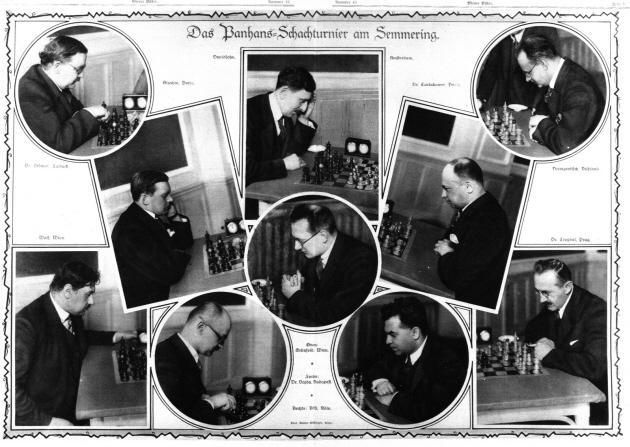
For the particular significance of the shot of Alekhine, see A Fake Chess Photograph.
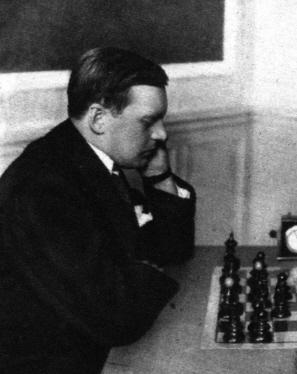
Alekhine at Semmering, 1926
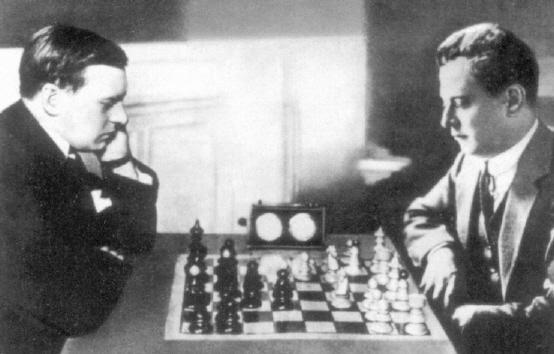
‘Alekhine v Capablanca, Buenos Aires, 1927’ (fabricated photograph)
7972. Alekhine’s Gun (C.N.s 7880 & 7914)
From Christian Sánchez (Rosario, Argentina):
‘I have found a reference to Alekhine in Russian sources. Fundamentos estratégicos del ajedrez edited by Yakob Estrin (Barcelona, 1985) has the following on page 24, in a chapter by B. Zlotnik (below the relevant diagram):
“Las piezas blancas están idealmente colocadas para penetrar en el campo enemigo. A esa manera de disponer la artillería se le suele dar el nombre de Alekhine, por ser típica del antiguo campeón mundial y sin duda también debido al gran efecto que produjo en una famosa partida jugada en San Remo, en 1930, entre Alekhine y Nimzowitsch.”
The Spanish book comprises only section two of the original work, Теория и практика шахматной игры (Moscow, 1984 [first edition: 1981]), where page 43 has this:
English translation of the marked passage:
“The white pieces are ideally situated for the invasion of the enemy camp. Such an arrangement of the heavy pieces is often called Alekhine’s/Alekhinian, probably on account of the famous game Alekhine v Nimzowitsch (San Remo, 1930).”’
7973. Alekhine abused
An article by G.H. Diggle in the November 1979 Newsflash and on page 52 of Chess Characters (Geneva, 1984):
‘Of all ex-world champions, Alekhine has (from some quarters) been “most notoriously abused”. For example, Harold Schonberg (Grandmasters of Chess) while acknowledging the master’s genius, opines that “few would care to say much in his favor as a human being”. He was, it seems, a “loner” and a “social monster” – he could not bear to lose at chess or even at more frivolous pastimes – amongst other disagreeable accomplishments he was, in adversity, an inveterate ping pong ball crusher. On one occasion (we read) when his opponent stood at match point, the Doctor “grabbed the ball”, shouted “Stop the game! Adjourned!” and then “tried to pass it off as a joke”. (But perhaps it was a joke; though not so good as the one about the wealthy “Britisher” of foreign extraction, who attempted to ride to hounds, but soon exclaimed: “Hi! Stop ze chase! I tumble! I fall off! Stop ze fox!!”)
But William Winter (Kings of Chess), who was Alekhine’s companion at many congresses, gives a far more favourable picture. “He was excellent company and full of good stories about his fellow-masters, all completely unmalicious. An excellent trait in his character was the generous praise he was always willing to bestow on any fine performance by one of his rivals. For example, he described the game played by the British champion, Yates, against Vidmar at San Remo as ‘the greatest game since the War’.” He also called one of his own losses to Yates a “belle partie”. Winter’s estimate is supported fully when one examines Alekhine’s notes to My Best Games of Chess, Nottingham, 1936 and The World’s Chess Championship, 1937 (v Euwe). They are unbiased, human and often humorous. He calls Euwe’s 35th move in Game 19 a defence “which, in my opinion, very few masters would have found” and Euwe’s king’s knight in Game 25 “the most hated knight of the match”. He is always scrupulously fair to Capablanca, with whom he was then at variance; and he deals with his own blunders without extenuation: “An awful move; the fact that White was very short of time is, to my mind, as little to be considered as an excuse as, for instance, the statement of the law-breaker that he was drunk at the moment that he committed the crime. The inability of an experienced master to deal with the clock should be considered as grave a fault as a miscalculation.”
He was, no doubt, in some respects, an unreliable man. An eminent chess editor (who had known all three masters) once told the BM that had any journalist attempted to arrange interviews with Fischer, Alekhine and Botvinnik respectively, Fischer would not have “bothered with the guy”, Alekhine would have said “Yes” and then failed to turn up, and Botvinnik would not only have granted the interview but would have been there dead on time.’
As regards Alekhine and table tennis, see page 152 of The
World’s
Great Chess Games by Reuben Fine (New York, 1951)
and some remarks by Spassky in an interview with Leonard
Barden on page 13 of the January 1970 Chess Life &
Review. Concerning Vidmar v Yates, see C.N. 3227
(page 123 of Chess Facts and Fables).
7974. Pronunciation of Alekhine’s name (C.N.s 4284, 4289 & 4304)
In response to the question at the end of C.N. 4289, Vitaly A. Komissaruk (Kasan, Russian Federation) quotes from page 177 of Lev Lubimov’s book На чужбине (‘In Exile’), published in Moscow in 1963 and reprinted in Tashkent in 1965:
‘“Шахматный король” – так звали А.А. Алехина за границей и так он сам себя называл -- выехал из России ещё молодым.Он воспитывался в училище правоведения, вырос в старорежимном кругу. Любил подчёркивать, что он хорошего дворянского рода, упорно настаивал, чтобы фамилию его произносили без точек над “е”. Когда, например, кто-нибудь спрашивал по телефону, можно ли поговорить с А.А. Алёхиным, он неизменно отвечал: “Нет такого, есть Алехин.”’
English translation:
‘“Chess king”, as A.A. Alekhine was known abroad and as he called himself, left Russia at a very young age. He attended law college and was raised in circles known as “old regime” [i.e. before the 1917 Revolution]. He liked to point out his descent from a noble family and insisted on pronouncing his last name without the dots above the “e”. For instance, when anybody asked on the telephone for “A.A. Alëkhin” he would always reply, “Such a person does not exist; there is Alekhin”.’
7975. Semmering, 1926
The group photograph of Semmering, 1926 is well known, but Michael Negele (Wuppertal, Germany) has found a high-quality version with a full caption, on the cover page of Wiener Bilder, 21 March 1926:
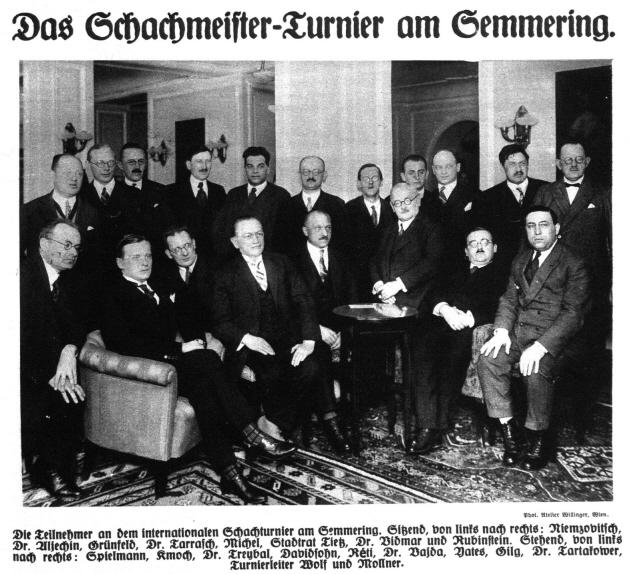
7976. R.D. Blackmore
A game by the author of Lorna Doone was published on page 114 of The Field, 31 January 1874:
Richard Doddridge Blackmore – Nelson Fedden
Correspondence (date?)
Centre Counter Game
1 e4 d5 2 exd5 Qxd5 3 Nc3 Qa5 4 Bc4 e6 5 d3 Nf6 6 Bd2 Bb4 7 a3 Bxc3 8 Bxc3 Qh5 9 Qxh5 Nxh5 10 Be5 Na6 11 O-O-O c6 12 d4 f6 13 Bg3 Nxg3 14 hxg3 b5 15 Bd3 h6 16 Bg6+ Ke7 17 Re1 Nc7 18 f4 Kd6 19 g4 Nd5 20 g3 Ne7 21 Bd3 Bb7 22 Rh2 Rae8 23 Rd2 Bc8 24 Rde2 Bd7 25 f5 exf5 26 gxf5 Nd5 27 Rxe8 Rxe8 28 Rxe8 Bxe8 29 Nf3 Bh5 30 Be4 Ne3 31 Nh2 Nc4

32 b3 Nxa3 33 c3 c5 34 dxc5+ Kxc5 35 b4+ Kd6 36 Bd3 Ke5 37 Nf1 Nc4 38 Nh2 a6 39 Kc2 Kd5 40 Kc1 Ne5 41 Kd2 Nxd3 42 Kxd3 Ke5 43 g4

43...Bxg4 44 Nxg4+ Kxf5 45 Ne3+ Kf4 46 Nf1 h5 47 c4 bxc4+ 48 Kxc4 h4 49 Kc5 h3 50 Kb6 Kf3 51 Kxa6 Kf2 52 Nh2 Kg2 53 b5 Kxh2 54 b6 Kg2 55 b7 h2 56 b8(Q) h1(Q) 57 Qb7+ Kh2 58 Qxg7 Drawn.
From D.J. Morgan’s Quotes and Queries column on page 23 of the January 1961 BCM:
‘R.D. Blackmore on Chess. We found this in the novelist’s biography by W.H. Dunn (page 174): “The only game worth playing!”, he once said to James Baker. “Think of the genius who invented the knight’s move.” He came to know Steinitz and H.F.L. Meyer.’
7977. US Presidents
Robert John McCrary (Columbia, SC, USA) writes:
‘I have come across additional references to chess and US Presidents since I published The Hall-of-Fame History of U.S. Chess. One reference concerns a White House chess set which became a campaign issue.
Page 148 of The Billiard Encyclopedia by Victor Stein and Paul Rabino (Minneapolis, 1996) states that John Quincy Adams’ list of White House furnishings, paid for by the US Treasury, included $23.50 for a chess set, along with additional funds for a billiard table and balls. A political opponent made an issue of these items, portraying Adams as a waster of public funds, and saying: “If the people tolerate the trifling expense of a billiard table, balls, and chessmen out of the public funds, what may they not expect?”
There was particular criticism of the billiard table as an example of a socially unacceptable game for a President.
I recall seeing a set owned by Adams in the Smithsonian, but I do not know whether it was the one which was made a campaign issue. The 1828 campaign between Adams and Andrew Jackson was especially fierce, filled with personal attacks.
I have also found a reference to Jackson having some interest in chess. Page 37 of American Lion. Andrew Jackson in the White House by Jon Meacham (New York, 2008) has an account of personal contact by Jackson with a lady:
“Julia Ann Conner owed Jackson a small debt: he helped her at chess. She was playing another houseguest, and Conner recalled that Jackson ‘stood at my side, and being an excellent player he frequently directed my moves – apparently much interested in the fate of the game’ ...”
Julia Ann Conner was a traveler from South Carolina, and the chess game was played at the Hermitage home of Jackson in September 1827.
Thus there is evidence that both the sixth and seventh US Presidents had an interest in chess despite being bitter opponents in politics. The Jackson reference is also a rare early mention of an American woman player. Benjamin Franklin played a number of women, but I have not seen any reference to his playing an American woman.’
7978. Quiz question
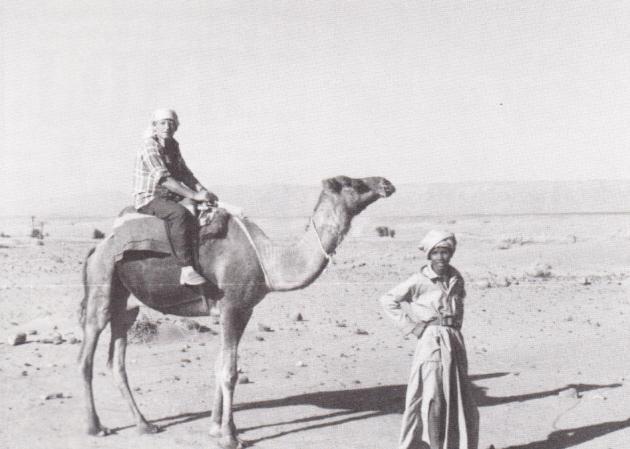
Name the chess master (top left).
7979. Greek gift
Our item below appeared on pages 21-22 of the Autumn 1996 Kingpin:
When was the Bxh7+/Ng5+ attack first played? In The Chess Companion Irving Chernev annotated the game Morphy v Guibert, Paris, 1858. After Black’s 7...h6, he wrote (page 186):
‘Anybody else would have castled and fallen into the trap 8 BxPch KxB 9 N-N5ch, etc. An old trap to you and me, but it was invented 25 years after this game was played!’
Chernev contradicted himself two pages later on (an item reprinted from his column in the July 1953 Chess Review):
‘Another little idea that Paulsen anticipated is the ritual sacrifice of BxPch in the French Defense. Credit is usually given to Fritz, who surprised Mason with it in the Nuremberg tournament of 1883. So here to dispute the claim is an entry from a match [Paulsen v Schwarz] played in 1879.’
But what about Greco’s use of Bxh7+/Ng5+ in the early seventeenth century? An example even appears on page 90 of a previous book by Chernev, 1000 Best Short Games of Chess.
Page 331 of Kings, Commoners and Knaves mentioned that in 1925 the second issue of Les Cahiers de L’Echiquier Français (page 59) suggested that the Fritz v Mason game was the earliest specimen of Bxh7+ in a tournament game.
Chernev’s article about the Morphy game had originally appeared on the inside front cover of the April 1950 Chess Review:
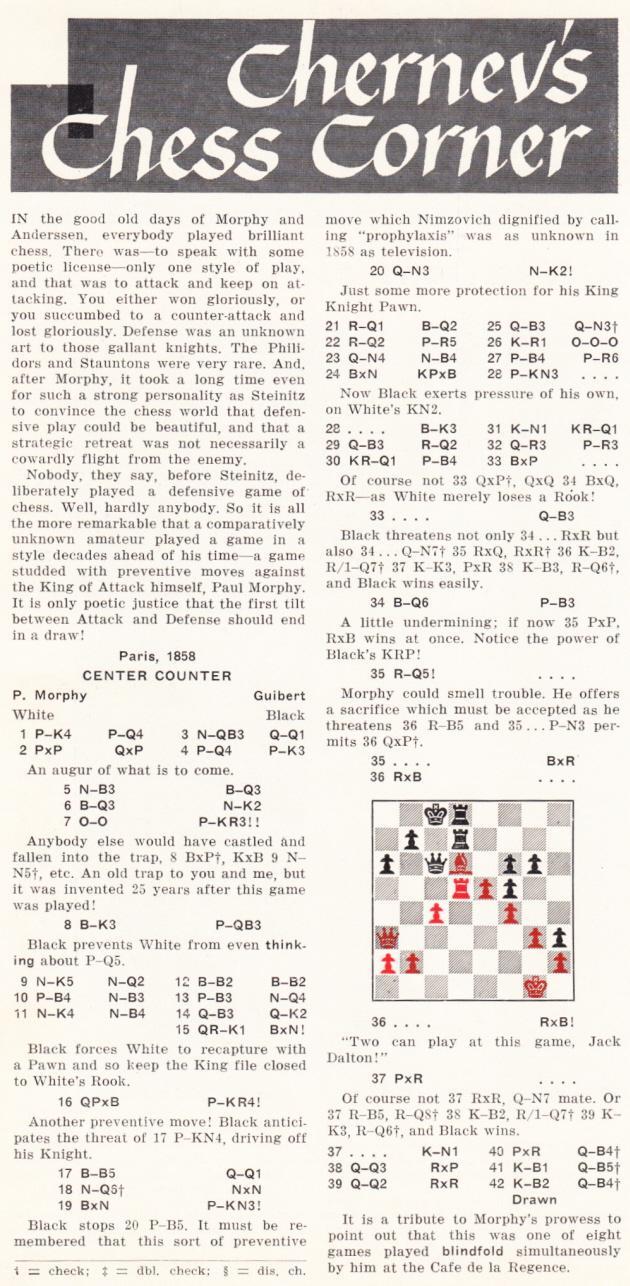
Is any biographical information available about Guibert?
7980. Introducing a beginner
On the same page of Chess Review which gave the Morphy v Guibert game Chernev wrote:
‘If I were introducing a beginner to the beauties of chess, I would show him first the game that Max Lange is said to have won from Adolf Anderssen. It is a short game, and that serves the purpose admirably. A longer game might bore a beginner. It is a witty game but not so brilliant as to dazzle him. It is just the sort of miniature that will whet his appetite and make him ask for more.’
Regarding the circumstances of that game/analysis, see pages 190-191 of Chess Explorations, page 63 of Chess Facts and Fables and C.N.s 3885 and 3888.
7981. Further
photographs from Wiener Bilder
Some more photographs submitted by Michael Negele (Wuppertal, Germany):
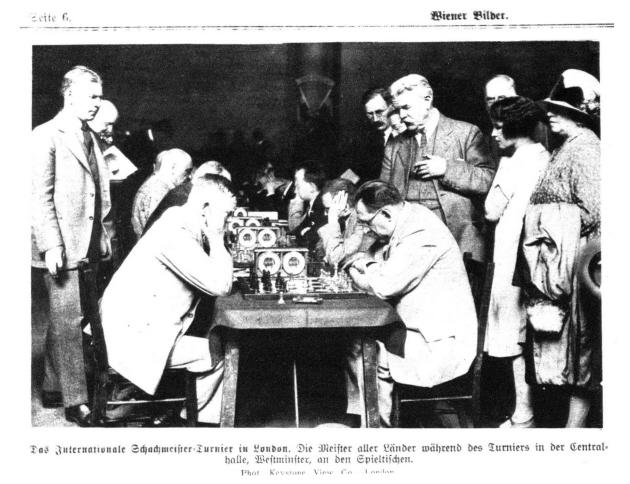
Source: Wiener Bilder, 31 July 1927, page 6. Our correspondent identifies the photograph as taken during the first round of the 1927 Olympiad in London (Austria v Finland, with S.R. Wolf (White) and J. Terho in the foreground).

Source: Wiener Bilder, 21 June 1936, page 6.
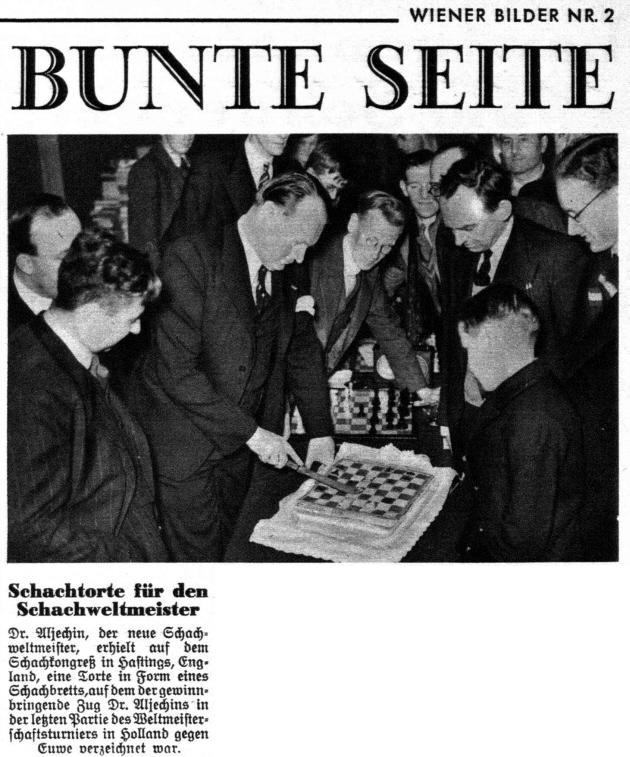
Source: Wiener Bilder, 9 January 1938, page 6. The occasion was mentioned on, for instance, page 79 of The World-Championship Match by B.H. Wood (Sutton Coldfield, 1938), and below we quote from page 26 of Chess for the love of it by A.R.B. Thomas (London, 1973):
‘Alekhine had just regained his world title from Euwe and he came to the congress [Hastings, 1937-38] as a spectator. In Holland he had been presented with a cake which showed the final position on the board when he regained his title. Before our first round started, he cut up the cake and gave each of us ten competitors a piece. Every day he watched the play intently and discussed the games afterwards with the players. More and more he convinced me that he truly loved chess and indeed was unable to understand that people could exist who were unable to sacrifice their whole lives to play chess, once they had learnt its beauty. He was an utterly dedicated man.’
7982.
Guibert (C.N. 7979)
From Rod Edwards (Victoria, BC, Canada):
‘Guibert’s first initial was “A.”, as given at the end of a set of game commentaries which he wrote for La Régence (April 1849, page 113). Page 36 of the February 1851 issue listed members of the Cercle des Echecs of Paris, including “Guibert, rentier, aux Batignolles 66, rue Saint-Louis”.
He was mentioned in Le Palamède as early as January 1845 (page 33) and was still playing in 1874, according to citations given by Etienne Cornil in his collection Le Café de la Régence (quoting La Stratégie, 15 January 1874 and Le Monde Illustré, 7 March 1874).
A number of references mention Guibert as one of the strongest Parisian players (e.g. the Chess Player’s Chronicle, June 1849, page 188 and La Régence, May 1849, page 129). Staunton, on page 365 of the Illustrated London News, 16 October 1858, evaluated Guibert and Bornemann as “a shade weaker” than Baucher and Seguin, who “might almost aspire to the honour of playing without odds against Mr Morphy”. (They were all amongst Morphy’s opponents in his blindfold simultaneous exhibition in Paris.)
In Morphy’s Games of Chess (page 182) P.W. Sergeant wrote: “Guibert, one of the strongest Parisian amateurs; d. 1878.”’
The death of ‘M[onsieur] Guibert’ was reported on page 245 of La Stratégie, 15 August 1878. Fifteen lines long, the obituary gave no biographical facts.
7983. The Immortal
Game (Piazza Riforma, Lugano, 1968)
From our collection:
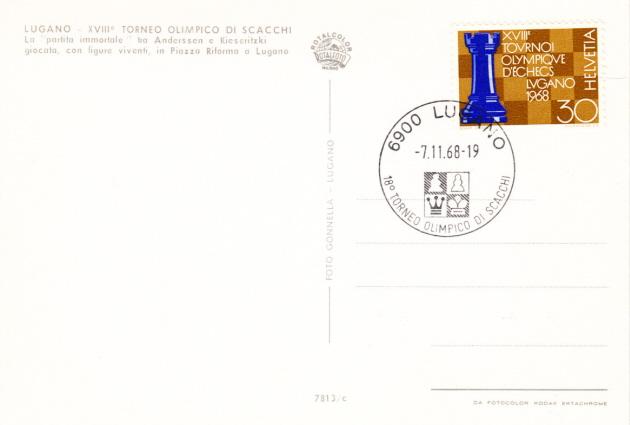
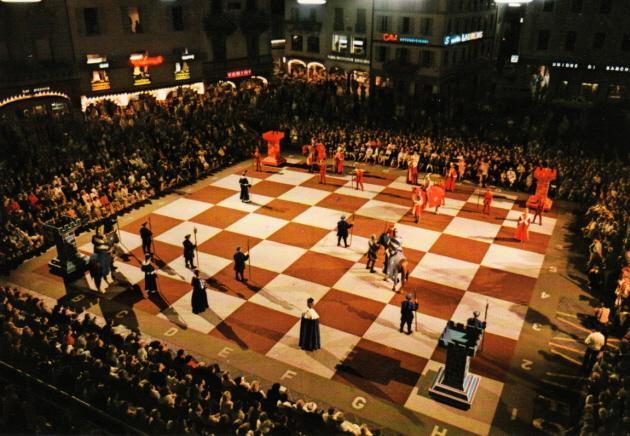
A report on the display, by Antonio Maspoli, was published on pages 164-165 of the September 1968 Schweizerische Schachzeitung.
7984. Kieseritzky/Kieseritsky
Can any case at all be made for the spelling Kieseritsky?
7985. Lasker quotation
Noting some observations attributed to Emanuel Lasker on pages 5, 11 and 181 of Improve Your Chess Results by Vladimir Zak translated by John Sugden (London, 1985), Jean-Pierre Rhéaume (Montreal, Canada) queries, in particular, the first of these, which reads:
‘In his Manual of Chess, Lasker wrote:
“A combination takes shape in a player’s head. Many thoughts – correct and erroneous, strong and weak, practical and impractible [sic] – strive for realisation. They keep being generated and contending amongst themselves, until one of them prevails over its rivals and is embodied on the chessboard in the shape of a move.”’
Our correspondent has been unable to find that passage in the Manual and asks for clarification.
Firstly, we note that the relevant text was on page 7 of the original of Zak’s work, Пути совершенствования (Moscow, 1981); Zak quoted accurately from Lasker’s book Учебник шахматной игры. Below is the text as it appeared on page 101 of the first edition (Moscow and Leningrad, 1926):
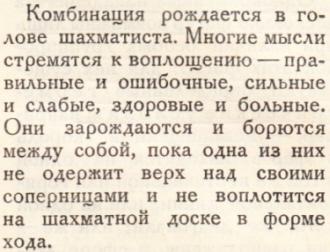
The Russian work was translated from Lehrbuch des
Schachspiels (Berlin, 1926), page 97 of which had
the following:
‘Die Kombination wird im Kopfe eines Schachfreundes geboren. Viele Gedanken kommen da zur Welt, richtige und falsche, starke und schwache, gesunde und kranke. Sie kommen zur Welt und stoßen einander, und einer trägt den Sieg davon über die Rivalen und setzt sich in einen Zuge auf dem Schachbrett um.’
Finally, below is the English version on pages 127-128 of Lasker’s Manual of Chess (New York, 1927):
‘The combination is borne in the brain of a chessplayer. Many thoughts see the light there – true and false, strong and weak, sound and sick thoughts. They are borne and jostle one another, and one of them, transformed into a move on the board, carries the victory over its rivals.’ [The wording was slightly different (e.g. born, not borne) on page 114 of the 1932 edition of the Manual.]
It would not have required excessive effort for Improve Your Chess Results to give Lasker’s own English text.
7986. Fool’s mate
An entry in the Oxford English Dictionary:
‘Fool’s mate n. Chess a form of game in which the first player, by two unwise moves, incurs checkmate at his adversary’s second move.
1618 J. Barbier Saul’s Famous Game Chesse-play (new ed.) xx. sig. E8, A Mate in two draughts ... which Mate for him that hath given him, may well ... be termd the fools mate.’
We should be grateful for a copy of the page in question, as well as any later citations illustrating the term’s progression into common parlance.
| First column | << previous | Archives [103] | next >> | Current column |
Copyright: Edward Winter. All rights reserved.
